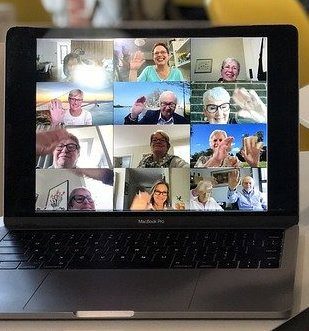When you are organizing a conference, be it virtual or In Real Life (IRL), among the more commonly used formats is the panel or a roundtable. In either case, the nature of the concept is a meeting of minds, an opportunity for conversation and debate around a given topic. Yet, most tables I see aren’t round and very few emcees manage to foster any real exchange. Instead, most of the time, it just seems like a lot of people talking at each other and us, the audience. When you want to run a panel online, the challenges get notably steeper.

One of the trickier elements of running a panel online, with a Hollywood Squares set up, is that it’s far less organic than one held IRL. I’d go so far as to say that, for all the ones I’ve attended, it’s mostly always a sub-par experience.
As an emcee of an online panel, your role is to make it all as seamless as possible. You have to do the intros, manage the baton between the speakers, keep on time, encourage debate and audience participation, all the while dealing with the imponderable tech issues such as when wifi or connectivity breaks down.
Getting the tech right
In the Lockdown Period, where everyone was having to log in from their homes, there is another set of issues with which to contend, such as inadequate equipment levels, poor lighting, uncooperative pets or kids, etc. Depending on your level of exigency, you’ll want to get out a set of instructions to all the panellists, indicating the best equipment set up, providing some guidelines and doing a video and sound check in advance.

An online panel comes with different challenges than IRL and these need to be accounted for. For example, when panellists are not “on” they are still visible to the attendees, so they should not distract from the others or act distracted. Depending on the platform used, your fellow panellists won’t know where anyone is located on the screen, so just keep talking to the camera. A pet peeve that gets me triggered is when moderators or panellists don’t shut off notifications, forget to mute themselves when not involved, or can be heard typing on their keyboard.
Audience engagement in 4 steps
The last tricky part is to find ways to engage the audience. The bigger the event and the larger the audience, the harder the challenge. However, without engagement and audience interaction, the question becomes why bother holding a live event. At least in a conference hall IRL, you can talk to your neighbour or meet someone on the way to grab a coffee. In a digital format, there are many ways to incite and encourage interaction, but that takes four key ingredients:
- Preparation (such as setting up polls or incorporating a tool like Slido)
- Energy (that needs to communicated through a screen) and good content
- An attitude that says that the people on stage can also learn from the audience — the power of collective intelligence. I like to say that you need to think through your viewer’s mind, their eyes, ears and bottom.
- A robust and stable platform that allows for interactivity and has a friendly UX (e.g. polls, surveys, chat, Q&A…)
In today’s socially savvy world, moreover, the interactions may be happening outside the platform. As the scale of your event grows, you will want to have an eye on what’s going on on social media, etc. That will likely require having outside help. It helps to channel your audience somewhere (like having a hashtag), but in the end of the day, it’s up to you whether you are interested in paying attention to your attendees (aka you customers).
Nothing douses audience enthusiasm more than ignoring incoming questions. As such, as the audience gets bigger, the more off-air help is required to help manage the number of inputs.
There’s a whole new metier out there when it comes to organizing and running a virtual panel. Nothing replaces having great content and sometimes that content can come from or be sparked by the audience. Having big names on the panel doesn’t necessarily guarantee a great panel either… depending on the size of the ego and/or complementarity with the other panellists. UPDATED June 10: Per a welcome comment on Linkedin, another way to gain in engagement is to ensure that the panel has diversity. That should be diversity of thought, gender balance and cultural differences.
One day maybe making a virtual panel online will be a piece of cake. For now, it seems to be missing the baking powder, much less the right eggs.
Happy to have your comments!
***If you like my writing and are interested in fostering more meaningful conversations in our society, please check out my Dialogos Substack. This newsletter will feature articles on why and how we can all improve our conversations, whether it’s at home, with friends, in society at large or at work. Subscription is free, but if you see value in it, you are welcome to contribute both materially and through your comments. Sign up here:












Trackbacks/Pingbacks